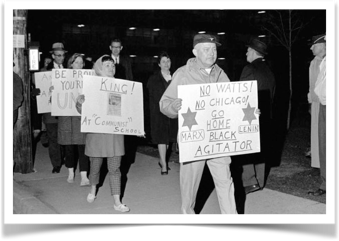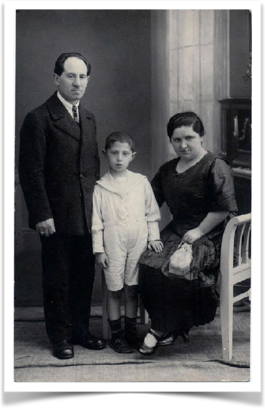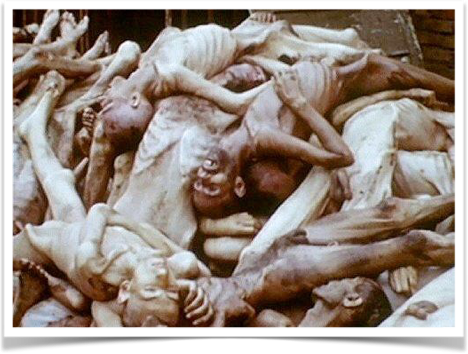This article is the final installment in a series by Lincoln S. Brandenburg that deals with the effectiveness of abortion victim images. If you have not already done so, please first read Part II and Part III, respectively.
“If Jesus, who was perfect, who never sinned, and who was love incarnate, could not speak the truth without being hated, rejected, and despised, who are we to think that we can do better?”
– Ben Davenport, pastor.
I’ll just say it: holding pictures of dead babies on a busy street corner is one of the most uncomfortable things a person can do to fight abortion (though asking people for money might top it). Besides the angry stares and being called names, there are concerns that cause some to question the effectiveness of abortion victim images. Let’s address these concerns:
Why not use positive, prenatal pictures instead of gory abortion images?
While prenatal pictures demonstrate the humanity of preborn children (and can be effective for some), they do nothing to horrify the viewer about the stark brutality of abortion. What portrays the horror of the Holocaust: a photo of a European Jewish family? Or pictures of bodies piled up in Auschwitz? Websites such as http://www.FacesOfDrunkDriving.com are effective because they not only show the faces of beautiful people – they show those same faces after being burned alive due to drunk driving.



Why not show pictures privately with consent, rather than forcing them on people in public?
The people who show up to events such as abortion debates are a) already pro-life or b) vehemently pro-abortion. The vast majority of people apathetic and ignorant – and quite happy to remain so. Most of them will never Google “abortion pictures” on their own accord. We simply cannot wait for them to come to us. The urgency of children being killed requires that we take our message to them – a LOT of them – NOW. To be passive “activists” would be a contradiction.
Those images turn people off, rather than promote thoughtful dialogue
This often mistakes popularity for results. By definition, no social reformer was popular during his time. Wilberforce had to hire a bodyguard after attempts were made on his life. MLK was assassinated. Jesus was crucified. The fact that some people oppose our work means that our message is pricking their conscience. And while those who are die-hard pro-abortion may oppose us loudly, that doesn’t mean that we aren’t reaching the many who sit on the fence… the many who would otherwise yawn at our small-scale, “cupcakes for life” activities.

What about children? They may be upset by seeing those images.
This concern is often raised by good people who are primarily considering their role as parents. They would prefer to talk with their children about abortion at a time of their choosing, instead of having it thrust upon them by pictures in the public square. They are (understandably) thinking about the well-being of their own children.
But as activists, we have to consider a bigger picture. Many parents will never educate their children about abortion. The extent of their discussion will be that “if you get pregnant, tell me early and we’ll get it taken care of.” Those children will likely never see the absolute evil of abortion apart from our pictures on the streets. If we can reach that child before they become sexually active and prevent them from having their baby killed in the future, love demands that we do so. There is no way (that I know of) to show the pictures to large amounts of people while shielding each child of good, pro-life parents. So we show them to the public, trusting that those who see them are the ones that God intended.
That being said, small children often don’t discern what is on the pictures. Older children’s response often mirrors the parent’s response. I have never seen a child who was not calm as long as the parent was calm. Parents regularly use our photo displays as a teaching opportunity for their children (and thank us for our work).
Children frequently become pro-life as a result of seeing abortion victim images. Kids are open-minded, blunt and still posses common sense. They haven’t yet been inoculated with the ideas of “reproductive freedom.” They know when they see our pictures that “it’s a baby.” They do not attempt to rationalize the indefensible. Internationally-acclaimed pro-life activist Lila Rose was first moved to stand up for babies who were being aborted when she was merely 9 years old… and saw a picture of an aborted child (check out Lila’s story at http://www.firstthings.com/article/2010/10/fighting-for-life)
People’s lives are more important than people’s feelings. We must ask ourselves: which is worse: for children to see the images and be upset? Or for children to continue to die? We will never end the killing by covering it up.
Post-abortive women may be hurt by those pictures
Our goal should never be to condemn women or men who have been involved in an abortion. As Christians who have ourselves been forgiven, we know that God is eager to forgive the sin of abortion, just as He is all sins.
According to many of my own post-abortive friends, the pictures are often a necessary tool in coming out of denial. No one wants to believe that they had their own baby killed, whatever the reasons. Acknowledging what was done is a necessary step towards experiencing the healing grace of God.
According to the Center for Disease Control, nearly half of all post-abortive women will have another child aborted at some point in their life. That’s a greater risk than the national average of 1 in 3 women who will abort. Again, human lives are more important than human feelings – and through compassion and post-abortive counseling resources, we can care for both.
Jesus would have used a less gory/more loving approach
The Crucifixion, while carried out by man, was orchestrated by God the Father. He could have chosen any way to have His Son sacrificed, and he chose the cross. It was a bloody, public spectacle that demonstrated the depraviltiy of our sin, as well as the great depth of love God has for sinners. The Gospels describe it in excruciating, macabre detail. There is no biblical basis for this suggestion.

The pictures show a truth that many find offensive. But we do not yell when we show them, overturn tables, chase people with whips or call them names such as “brood of vipers.” Christ – the incarnation of love itself – did each of these things when it was called for. It would be un-Christian for us to downplay the truth of abortion to our neighbors by making it seem less horrific than it is – not to mention, unloving to preborn children. Such inaction does not make us loving – it makes us spineless. To say that “Christ was love” does not necessitate that Christ was a pushover. Nor should we be.
“Take no part in the unfruitful works of darkness, but instead expose them.” – Paul, Ephesians 5:1
-Lincoln
Georgia Project Director, Center for Bio-Ethical Reform
~~~~~~~~~~~~~~~~~~~~~~~~~~~~~~~~~~~~~~~~~~~~~~~~~~~~~~~~~~~~~~~~~~~~
Thank you for taking the time to read this series. Even though I have been familiar with this approach to changing hearts about abortion, it was a tough read for me. Seeing the pictures is never, ever easy and I cry every time. My hope is that it will push us out of our apathy and cause us to be actively pro-life.
~Aimee







